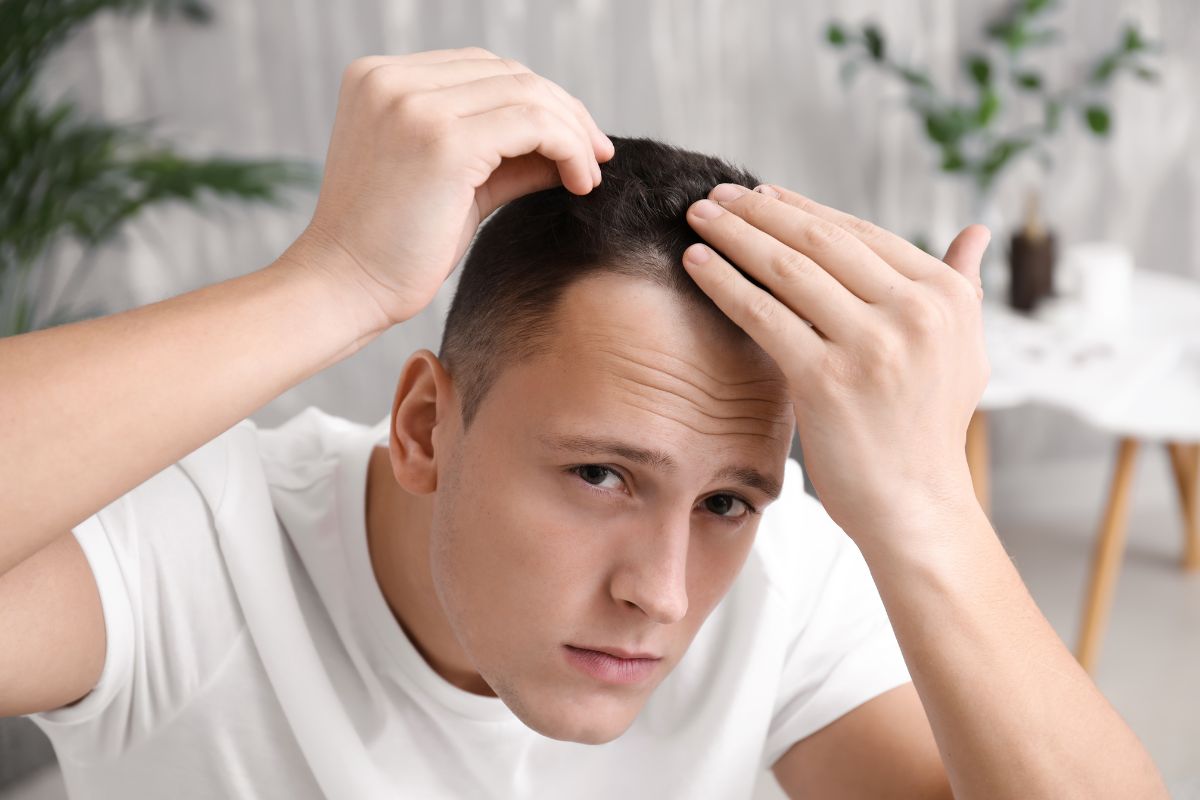By Marie-Royce Book, a Trichological Patient Advisor and Brow Transplant Specialist at the award-winning Wimpole Clinic.
Hair loss is no longer an issue just for ageing men; it’s becoming increasingly common among younger men, especially those trying to balance demanding careers with family life.

Modern lifestyles contribute significantly to this trend. Chronic stress, hormonal fluctuations, and unhealthy eating habits can lead to increased levels of dihydrotestosterone (DHT), a male hormone linked to hair loss. Additionally, diets lacking essential nutrients can impair hair health, making it more susceptible to thinning and shedding.
But with numerous treatments on the market, how do you know what actually works?
Understanding the Causes: Stress, Hormones & Lifestyle
It was previously believed that two-thirds of men will have some degree of hair loss by the time they’re 40, but now we know that the problem is more prevalent at a younger age. For entrepreneurs—especially papapreneurs with high-powered careers or the pressure of business growth and young families—stress is a major trigger for hair loss. Elevated cortisol levels from chronic stress can accelerate hair shedding and disrupt the natural hair growth cycle. Meanwhile, the hormone DHT (dihydrotestosterone) is often the primary cause behind male pattern baldness, gradually shrinking the hair follicles and preventing the production of new growth over time.
A lack of sleep, a nutrient-poor diet, and little time for relaxation can exacerbate the problem further, making it crucial to address the issue of hair loss with a comprehensive approach.
Regrow, Restore and Revive: The New Era of Male Hair Loss Treatments
Finasteride & Dutasteride: These DHT-blocking medications are FDA-approved and have been proven to slow down or reverse hair loss in many men. They are effective, but you have to stick to them to enjoy the best results. Keep in mind that there can be side effects, like changes in libido.
Minoxidil (Topical or Oral): Originally developed for blood pressure regulation, minoxidil has been a popular choice for hair regrowth. The oral version is gaining popularity, but topical minoxidil remains a go-to option for those cautious of possible side effects.
PRP (Platelet-Rich Plasma) Therapy: This high-tech treatment uses your own blood to boost hair growth by stimulating dormant hair follicles. It is ideal for early-stage hair loss and has shown promising results when it comes to thickening the hair.
Advanced Therapies: What’s New in Hair Restoration?
Exosome Therapy & Stem Cell Treatments: There’s some positive new research suggesting that exosomes and stem cell-based therapies may help regenerate hair follicles and boost hair growth. While it’s early days, more and more people are trying these cutting-edge treatments with some success.
Low-Level Laser Therapy (LLLT): Laser caps and in-clinic treatments using light energy can stimulate hair follicles and slow hair loss progression but are best used as a complementary treatment to promote hair regrowth.
Polynucleotides & Scalp Microneedling: Polynucleotide injections, made from DNA fragments, are being lauded for their ability to reduce scalp inflammation and improve hair growth. When combining microneedling with minoxidil or PRP, blood flow to the hair follicles can be boosted.
Lifestyle Changes: The Foundation of Healthy Hair
Diet & Nutrition: Hair thrives on protein, iron, omega-3s, and biotin. But if you have a diet high in processed foods and low in nutrients, this can speed up thinning. It’s a good idea to get your blood tested and, if required, try supplements that are specifically designed to boost hair health.
Stress Management: Meditation, cold exposure such as cryotherapy, and vagus nerve stimulation devices are becoming increasingly popular among high-performance professionals who want to reduce cortisol levels to keep stress in check and improve overall health—including hair preservation!
Sleep & Exercise: Skimping on sleep by working long hours or taking in too much screen time can increase inflammation and DHT production, which is not great for your hair. On the other hand, resistance training and moderate cardio improve circulation, helping to nourish your scalp and promote hair growth.
Surgical Options: When to Consider a Hair Transplant
For anyone dealing with serious hair loss, a hair transplant remains the most effective long-term solution. Whether you choose FUE (Follicular Unit Extraction) or FUT (Follicular Unit Transplantation), both methods can give you a natural-looking result when performed by skilled surgeons. Plus, improvements in preserving the donor area and unshaven techniques now make the whole process more discreet than ever before.
What is a Follicular Unit Extraction (FUE) Hair Transplant?
FUE is the most advanced type of hair transplant surgery. It involves removing groups of healthy hair follicles individually from the donor site and transplanting them into the thinner areas, usually around your temples and crown.
By using the latest minimally invasive hair restoration techniques, it can create natural-looking results that are indistinguishable from your existing hair, giving you an age-appropriate hairline and restoring your confidence. FUE offers a fast recovery time as well and minimal scarring.
What is a Follicular Unit Transplantation (FUT) Hair Transplant?
FUT is a common hair transplant method. In FUT, the surgeon removes a strip of skin containing active hair follicles from the back or side of your head. They then dissect it into tiny follicle clusters known as grafts, which can contain single or multiple hairs. Each graft is then transferred into the bald or thinning areas.
While the recovery period is longer and there’s a higher risk of scarring, FUT allows more grafts to be extracted from a smaller area. And just like FUE transplants, a natural-looking hairline that blends in with the rest of your hair boosts your confidence and your hairline.
A Final Word: Taking Action Early
The key to tackling hair loss is to address it early and evaluate whether lifestyle changes, advanced therapies, or medical treatments will be the right route for you.
For entrepreneurs who value their time and image, understanding the options will make all the difference in preserving your confidence and appearance.
Given that there is no single solution for everyone, it is important to consider the variety of science-backed treatments that are available today. So if you are worried about thinning or receding hair, the smartest move is to chat with a specialist who will create a plan that best addresses your needs and your lifestyle.
About the expert
Marie-Royce Book is a Trichological Patient Advisor and Brow Transplant Specialist at the award-winning Wimpole Clinic. She is an expert in hair restoration solutions, offering advice on both non-surgical treatments and surgical procedures.

Marie consults on a range of non-invasive treatments, including PRP (Platelet-Rich Plasma) therapy, low-level laser therapy, and scalp micropigmentation to promote hair growth and improve overall scalp health. In addition to non-surgical options, Marie assists in surgical procedures such as scalp, beard, brow, and pubic hair transplants. She works closely with patients to ensure personalised care and excellent results using advanced techniques like FUE (Follicular Unit Extraction) and FUT (Follicular Unit Transplantation).
The Wimpole Clinic is renowned for its advanced and innovative approach to hair restoration. Find out more at www.wimpoleclinic.com


